Galapagos Sky, Galapagos IslandsContents of this Issue: Galapagos Sky, Galapagos Islands It’s Not Just the Fishermen Who Are Destroying Reefs What Rats Can Tell Us about Drinking, Diving and DCS The Sun Diver Loses Another Diver Bahamas, French Polynesia, St. Vincent There’s More to Undercurrent Than This Issue From Shark Baiters to Shark Riders? What Every Liveaboard Needs for Their Aging Clientele Nudibranch and Sea Slug Identification: Indo-Pacific Getting a Post-Dive Call from the U.S. Air Force Travel Agent or the Internet? Part I What Really Happened to the Truk Siren? Editorial Office: Ben Davison Publisher and Editor Undercurrent 3020 Bridgeway, Suite 102 Sausalito, CA 94965 where the wild things are from the February, 2016 issue of Undercurrent
Dear Fellow Diver: I now understand why divers say the Galapagos is one of the finest dive destinations in the world. I knew it was not for beautiful coral reefs, as the Galapagos has very few, nor for brightly colored tropical fish. But until I dived this ocean of giants, this underwater Jurassic Park, I just didn’t understand its power. Close encounters with whale sharks, bottlenose dolphins, manta rays and hammerhead sharks were common. Yes indeed, if I may borrow from Maurice Sendak, this is where the wild thing are. I journeyed aboard the 83-foot Galapagos Sky, launched in 2001 by Santiago Dunn and now managed by Peter Hughes himself. It holds 16 guests in eight double cabins and is well equipped with navigational and safety equipment. Safety must be the hallmark in these waters. The crew provided dive beacons, and we were given instruction on their use. They also fitted a dive horn on each BC because this can be tough diving; hence their rule: Always stay with your dive buddy and your dive-master (I was glad to follow the guide who was instrumental in spotting things I would have missed, as well as creating opportunities to see the large creatures).
The next morning, Fabrizio Carbo, who has been a divemaster in these waters for 30 years, guided us on our first real dive. He signaled to our group of five to hug a rock cliff -- the lower our profile, the better chance for a close encounter. Clinging to the rocks, I peered into the deep blue. Slowly a shape materialized from the gloom. A manta ray as large as our Zodiac was swimming right toward us. As it flew over our heads, it looked like a 747 flying by. A second, then a third manta appeared. As if in slow motion, the five-meter ray gracefully soared over my head, so close I could have touched him. I thought to myself, “I’m done.” I could have packed my bags right then and left, and this would have still have been a successful trip. Back on the Galapagos Sky, I socialized with the gang who would be my shipmates for this seven-day voyage. Your fellow divers can make or break the entire liveaboard experience, but my luck was good, as this was indeed an interesting group of people. Five gregarious Ukrainians on our boat were a wild bunch, with a good sense of humor that led to many off-the-wall comments. They wanted to drink beer and do tequila shots in-betweens dives, but that didn’t go down, so they waited till their diving was done, then accompanied their shots with cigars outside. My wife and I shared a dining table with Eric from France and Francis from the Canary Islands, both seasoned divers. We had great dinner conversations and swapped many good dive stories.
For me and many of my dive companions, four dives a day was a handful, which is perhaps why no one accepted the only night dive offered, a fifth dive that day. Burning all those calories was great, so I felt no guilt when it was time to eat, and the Sky’s chefs produced plentiful and excellent meals. The sit-down dinners had a selection of two entrées: for example, octopus Basque style, with peppers and sauteed potatoes, or pork loin and vegetable stir fry with pineapple sauce and steamed rice, preceded by a dried fruit timbale served with fennel salad, and followed by berries panna cotta. Wow. Typical buffet breakfast: fresh tropical fruit, granola and cereals, fresh breads, a meat and cheese plate, crepes stuffed with blackberry jam and cottage cheese. Or eggs perico style, and mashed green plantain with cheese. A typical buffet lunch: warm vegetables salad with garlic drizzle, tuna tartar or chicken lasagna or shrimp skewers and baked polenta, followed by tiramisu or fresh fruit. Sodas, beer and wine were free. One night, we had lobster the chef had purchased from local fishermen; another night an on-deck BBQ with chicken, beef and shrimp skewers was a ton of fun. Still hungry? A snack bar was stocked with cookies, chips, power bars and dried fruit.
My dives at Wolf Island were particularly memorable. On one dive, several large moray eels swam from rock to rock while a couple of sea lions darted in and out of our group, providing an acrobatic spectacle that put Cirque de Soleil to shame. Agile and curious, the sea lions loved to play with us divers. They barreled toward me at great speed, then turned at the last moment just inches from impact, at times brushing me with their whiskers. And hammerheads . . . what bizarre twist of evolution led to the creation of this most unusual shark? Eyes jutting out from the tips of its T-shaped head to its gaping jaws full of razor-sharp teeth. We encountered dozens of hammerheads, at lengths exceeding four meters, dwarfing us divers. Bottlenose dolphins circled us, at times swimming no more than a foot away. I guessed their speed and agility was in the same ratio to mine, as mine would be in ratio to a giant land tortoise. When we surfaced, we were greeted by half a dozen red-footed boobies hovering a meter above. Landing in the water next to us, they poked their heads underwater to see if we had attracted tasty morsels for them. It’s this proximity to ordinarily shy creatures that makes the Galapagos Islands such an extraordinary venue.
The iconic pinnacle of Bartolome Island loomed overhead, its summit reached by 365 stairs. At Wolf Island, I encountered plenty of bottlenose dolphins, and in one instance, a huge bait ball. As I swam in and out of it, the apparently dull fish, turning in unison to a different angle with the sun, provided a dazzling lightshow of silver and sparkles, just the thing to confuse predators. Darwin’s Arch, on the very remote Darwin Island, is considered by some to be the best dive on our planet. No one may step on the island without a government permit, and no tour boats are allowed in the waters. Only a few dive boats venture out this far. The spectacular arch rises from the depths to a lone tower, half a mile from Darwin’s Island. Here, the Humboldt Current brings in rich nutrients. Numerous cleaning stations attracted those large pelagic animals I came to see. Manta rays and bottlenose dolphins entertained us, but no whale sharks. The season is June to November, and I was there in December. Oh well. The dive briefing room was a spacious U-shaped couch, with fish ID books, dive information and maps. Two large LCD TVs on each side allowed for plenty of movie viewing, and while the Ukrainians watched Russian movies, the rest of us watched such fare as Forrest Gump. The Sky is well designed, with polished railings, banisters and stairs. On the top deck, I kicked back in a lounge chair or hammock, watching frigate birds, resplendent with their red pouch under the bill, glide 10 feet above. My cabin, the smallest on board, was still quite comfortable, with two decent single beds, and lots of room and shelf space for camera gear, clothing and odds and ends. The spacious head sported a large sink, lots of counter space and a shower large enough for two. Fresh towels were delivered daily when the room was cleaned.
At Rocha Redonda, fumerals bubbled from the ocean floor. Red, orange, white, yellow and green lichen covered the rocks. I set up a GoPro on a Gorilla Pod, weighted it down with a 3-pound weight, and pressed the video record button, giving me a rock-solid, documentary-style video (like having a real underwater tripod) of this unusual geologic feature. I’m skilled enough to teach land photography, but underwater photography is not my strong suit. However, Francis Pérez, one of my fellow travelers, turned out to be a master underwater photographer. When I viewed his photos, I knew I felt like a piano student in the presence of Mozart. Off Pinzon Island, I marveled at the array of colors on a pair of lobsters. A foraging banded sea snake methodically searched every nook and cranny for food, once violently wriggling his body as he devoured some unsuspecting critter. Stingrays, morays and turtles became commoners, and for a while, I watched a large horse conch, big as a volleyball, propel himself along by his purple-spotted foot muscle. And then there is the bizarre red-lipped batfish. Picture a white bat crawling along the sea floor on its wings. Now add Angelina Jolie’s lips and apply a generous helping of bright red lipstick. OK, that’s a red-lipped batfish. We made it safely back to port on Santa Cruz Island, where we had an opportunity to take a land excursion to see the giant Galapagos tortoises. These ponderous beasts were almost wiped out by early sailors. Fortunately, the Ecuadorian government has made great progress in restoring their population. I also explored several of the huge lava tunnels that helped to form these islands over 1.5 million years ago. Some divers, so intent on spending every minute in the water, often don’t leave themselves time to see Galapagos topside -- don’t make the same mistake. In fact, my wife and I spent three weeks in the Galapagos Islands, including a full week on land at the Royal Palm on Santa Cruz Island, where we booked day excursions and another week on a tour boat, the Ecoventura. Indeed, the diving was great, even on the many dives (23 were offered) I haven’t described. What made this trip truly memorable for me was not what I expected. Sure, I loved the wild things -- mantas, dolphins, hammerheads, the red-lipped bat fish and the fumerals. And every dive, other than the checkout dive, was splendid. But I will cherish the good times I had on the boat, especially with our two outstanding divemasters, Fabrizio and Max Castillo -- really good guys, funny, friendly, exceptionally knowledgeable and helpful. If I return to the Galapagos someday, it will surely be on the Galapagos Sky. P.S. You can check out some videos I took on this trip and uploaded to YouTube of fumerals (https://youtu.be/vWwimhyDlMU), sea lions (https://youtu.be/-gv3SI59xSg)and the Bartolome Time lapse - (https://www.youtube.com/watch?v=G6zhr26Qsn8). -- S.N. Our undercover diver’s bio: While you read this, our author, who has well more than 500 dives under his belt, is aboard the Ocean Princess as it circumnavigates the continent of South America on a 64-day cruise. He is delivering 32 lectures on both photography and modern technology, traveling with a drone that shoots 4K video.
|

I want to get all the stories! Tell me how I can become an Undercurrent Online Member and get online access to all the articles of Undercurrent as well as thousands of first hand reports on dive operations world-wide
| Home | Online Members Area | My Account |
Login
|
Join
|
| Travel Index |
Dive Resort & Liveaboard Reviews
|
Featured Reports
|
Recent
Issues
|
Back Issues
|
|
Dive Gear
Index
|
Health/Safety Index
|
Environment & Misc.
Index
|
Seasonal Planner
|
Blogs
|
Free Articles
|
Book Picks
|
News
|
|
Special Offers
|
RSS
|
FAQ
|
About Us
|
Contact Us
|
Links
|
3020 Bridgeway, Ste 102, Sausalito, Ca 94965
All rights reserved.

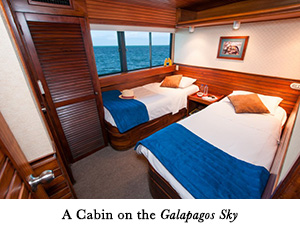 We boarded in the afternoon, and after briefings,
motored to our checkout dive in an ugly area with poor
visibility and little
of interest to
see (our only poor
dive). That gave me
plenty of time to
adjust my gear and
ensure I was properly
weighted.
We boarded in the afternoon, and after briefings,
motored to our checkout dive in an ugly area with poor
visibility and little
of interest to
see (our only poor
dive). That gave me
plenty of time to
adjust my gear and
ensure I was properly
weighted.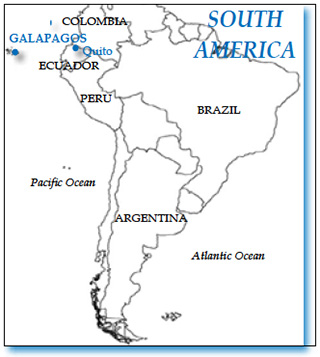 Our voyage on the twin-engine Galapagos Sky would visit many
islands
in the
archipelago, traveling from San Cristobal Island, where we boarded, to
Darwin
Island, 124 nautical miles to the north, crisscrossing the equator
several
times. We traveled mostly by night, and the rocking boat was as
soothing and
restful as a hammock on a summer day. The Sky carries two Zodiacs
(called “pangas”),
each holding eight divers, plus the divemaster and driver. On the
mother
boat, the crew helped each of us gear up before a dive and assisted us
into
our panga, where the crew helped us to our seats, then delivered fins
and cameras.
On rough days, the surge caused the panga to rise and fall as much
as
two
meters, making it a real balancing act to step safely into the panga,
so their
help was essential. Back on the Sky after each dive, I was handed a
cup
of hot
chocolate and a freshly baked pastry while the crew helped me out of my
wetsuit.
Our voyage on the twin-engine Galapagos Sky would visit many
islands
in the
archipelago, traveling from San Cristobal Island, where we boarded, to
Darwin
Island, 124 nautical miles to the north, crisscrossing the equator
several
times. We traveled mostly by night, and the rocking boat was as
soothing and
restful as a hammock on a summer day. The Sky carries two Zodiacs
(called “pangas”),
each holding eight divers, plus the divemaster and driver. On the
mother
boat, the crew helped each of us gear up before a dive and assisted us
into
our panga, where the crew helped us to our seats, then delivered fins
and cameras.
On rough days, the surge caused the panga to rise and fall as much
as
two
meters, making it a real balancing act to step safely into the panga,
so their
help was essential. Back on the Sky after each dive, I was handed a
cup
of hot
chocolate and a freshly baked pastry while the crew helped me out of my
wetsuit.
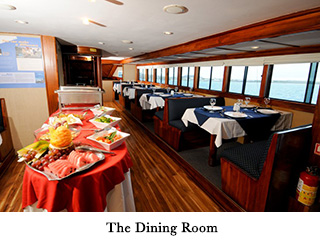 Galapagos waters are colder than most tropical locations, but on my
November
trip they ranged from the low 70s to the low 80s, warmer than usual
thanks to
El Niño. Almost everyone wore a full 3-mil suit with hoods, but I got
by with a
3-mil shorty and no hood.
Galapagos waters are colder than most tropical locations, but on my
November
trip they ranged from the low 70s to the low 80s, warmer than usual
thanks to
El Niño. Almost everyone wore a full 3-mil suit with hoods, but I got
by with a
3-mil shorty and no hood.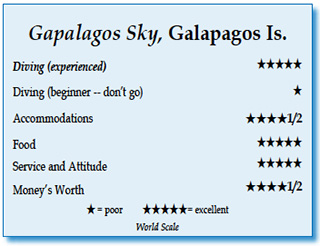 On shore, several penguins preened and sunned themselves. I waited
in the
water, hoping a penguin would decide to take a dip, and lo and behold,
one awkwardly
ambled forward and slipped into the water. I followed him with my video
camera close range. Then two meters below the surface, I spotted a cave
at the
shore’s edge. From inside, a pair of large eyes watched me. It was a
silky shark
about two meters long. And then more eyes gleamed . . . four, six,
eight . . .
four silkies spying me.
On shore, several penguins preened and sunned themselves. I waited
in the
water, hoping a penguin would decide to take a dip, and lo and behold,
one awkwardly
ambled forward and slipped into the water. I followed him with my video
camera close range. Then two meters below the surface, I spotted a cave
at the
shore’s edge. From inside, a pair of large eyes watched me. It was a
silky shark
about two meters long. And then more eyes gleamed . . . four, six,
eight . . .
four silkies spying me.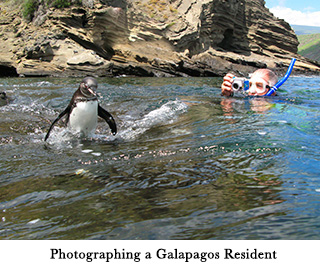 Not every trip goes exactly as planned.
At the most isolated point of our trip, boat captain Andres Ramirez
summoned us divers to a meeting. Andres, about 30
years old, was on his first voyage as captain and had important news:
One of
the boat’s two engines had failed. We could only travel at half
speed. How a
crew reacts when problems strike tells me a lot about a dive company,
and I was
impressed with how the crew dealt with this new deck of cards. Francis,
Eric and
I talked with Captain Andres to get a clearer picture of our options,
and together
we decided on a new itinerary. We traded in a few dives west of Isabela
to
dive on an active geological site at Rocha Redondo and then move to
Pinzon. This
provided a more direct course back to San Cristobel Island, a prudent
decision
given our circumstances.
Not every trip goes exactly as planned.
At the most isolated point of our trip, boat captain Andres Ramirez
summoned us divers to a meeting. Andres, about 30
years old, was on his first voyage as captain and had important news:
One of
the boat’s two engines had failed. We could only travel at half
speed. How a
crew reacts when problems strike tells me a lot about a dive company,
and I was
impressed with how the crew dealt with this new deck of cards. Francis,
Eric and
I talked with Captain Andres to get a clearer picture of our options,
and together
we decided on a new itinerary. We traded in a few dives west of Isabela
to
dive on an active geological site at Rocha Redondo and then move to
Pinzon. This
provided a more direct course back to San Cristobel Island, a prudent
decision
given our circumstances. Divers Compass: Until June 1, the cost for seven days is a pricey
$5,495 per person; for 10 days, it’s $7,855 . . . If you don’t
want to tote your equipment, they have rental equipment available,
but it’s wise to be wearing familiar gear . . . The colder
the water is, the better the large animal encounters; while El
Niño may play havoc with sightings, the best months are normally
June through November . . . For photographers, the vessel has a
dedicated rinse tank, an equipment area and sizeable charging station
. . . This is nitrox diving, with larger tanks available for
heavy breathers . . . Website –
Divers Compass: Until June 1, the cost for seven days is a pricey
$5,495 per person; for 10 days, it’s $7,855 . . . If you don’t
want to tote your equipment, they have rental equipment available,
but it’s wise to be wearing familiar gear . . . The colder
the water is, the better the large animal encounters; while El
Niño may play havoc with sightings, the best months are normally
June through November . . . For photographers, the vessel has a
dedicated rinse tank, an equipment area and sizeable charging station
. . . This is nitrox diving, with larger tanks available for
heavy breathers . . . Website – 